Why Fixed Income Real Estate Investments Appeal to Retirement-Focused Investors
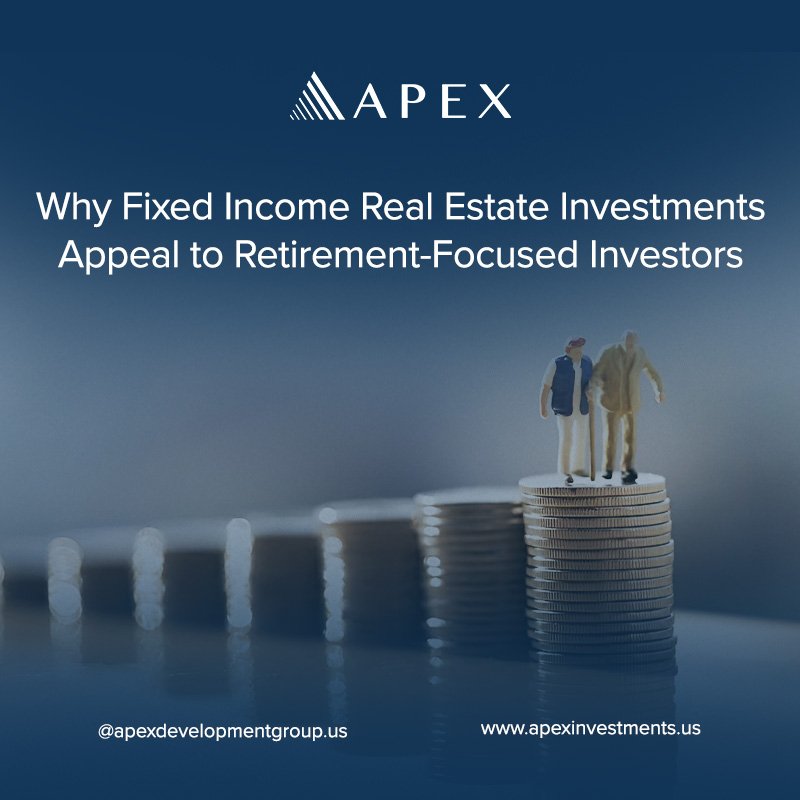
Home Why Fixed Income Real Estate Investments Appeal to Retirement-Focused Investors Blog · December 04, 2025 As retirement approaches, the investment priorities of individuals often shift dramatically. The focus typically moves from aggressive growth to wealth preservation and, most critically, generating a predictable, steady income stream. This shift makes Fixed Income Real Estate Investments an incredibly appealing asset class for those planning their golden years. These strategies offer a unique blend of stability, inflation protection, and consistent cash flow—qualities that perfectly align with a retirement-focused investor‘s needs. The Allure of Predictable Cash Flow The core attraction of Fixed Income Real Estate Investments is the reliable income they are structured to provide. Unlike volatile stock dividends or pure growth plays, these investments, often taking the form of debt or preferred equity positions in real estate projects, offer contractual, periodic payments. This predictable payout is essential for retirees who depend on their portfolio to cover daily living expenses. Many retirement strategies revolve around the “4% rule,” but a reliable income stream from assets like a real estate income fund offers a tangible alternative. The stability inherent in real estate debt minimizes the fear of capital loss compared to equity-based investments. Apex Investment Group recognizes this need for stability, structuring offerings like the Apex Infinity Fund to provide a fixed returns structure. Mitigating Risk Through Real Estate Stability Diversification is a cornerstone of sound portfolio management in real estate and retirement planning. Fixed Income Real Estate Investments generally exhibit a low correlation with traditional stock and bond markets, providing a critical buffer during economic downturns. This stability helps to navigate market fluctuations with confidence. Real estate itself is a tangible asset, offering a sense of security that paper assets cannot match. In the fixed income space, the investment is secured by the underlying property, reducing default risk for the investor. This approach is a key strategy within alternative investment management strategies, specifically designed for lower volatility. The Power of Inflation Protection Inflation poses one of the greatest long-term threats to a retiree’s purchasing power, gradually eroding the value of savings. Real estate is often cited as a powerful hedge against inflation. While equity real estate benefits from increasing property values, Fixed Income Real Estate Investments also offer protection. The returns in many real estate debt or preferred equity funds are set at a rate that is competitive and often surpasses the long-term inflation average. Furthermore, the underlying value of the asset—the property—tends to increase with inflation, further securing the investment. This makes passive income from real estate investment a more robust source of funds than many pure debt instruments. Accessing Real Estate Without the Management Hassle For the retirement-focused investor, the thought of becoming a landlord—dealing with tenants, maintenance, and day-to-day operations—is highly unappealing. This is where private equity real estate funds and similar investment vehicles shine. They allow investors to enjoy the benefits of real estate ownership without any active involvement. This truly passive investment model aligns perfectly with the desire for a work-free retirement. Real estate investment management companies like Apex handle all the professional management, from acquisition to distribution. Investors benefit from the expertise of asset management real estate companies who specialize in optimizing property performance and financial outcomes. Structuring Your Financial Future with Fixed Returns The structure of a real estate income fund is specifically engineered to meet the needs of those seeking reliable income. These funds pool capital to invest in a diversified portfolio of income-producing real estate debt or structured investments. The defined returns offer predictable income that can be easily factored into a retirement budget. This differs significantly from traditional private equity real estate investment, which is typically focused on maximizing capital appreciation through property sales or refinance, often with longer time horizons. Fixed Income Real Estate Investments prioritize regular cash distributions, offering a clear path to financial independence. This makes them one of the best passive real estate investments for older investors. The Role of Professional Management and Diversification Retirement portfolios should be characterized by diversification and professional oversight. Investing through established real estate investment management companies provides both. These firms possess the market knowledge, underwriting expertise, and scale to select and manage high-quality assets. Apex Investments, for instance, focuses on strategic business plans for institutional investors, family offices, and high-net-worth individuals, bringing a high level of professional management to your investment. A real estate income fund offers a diverse array of units and opportunities spanning multiple asset classes, which minimizes concentration risk. This approach helps alternative investment companies provide a path to passive income from real estate investment that is both secure and expertly managed. Why Fixed Income Real Estate Investments Work in Retirement Fixed Income Real Estate Investments work so well for retirees because they deliver on the fundamental requirements of this investor demographic: security, income, and simplicity. They are an essential piece of the puzzle when creating a resilient portfolio designed to withstand economic cycles and provide for a comfortable life after employment. The underlying nature of real estate—tangible, cyclical, and demand-driven—makes the debt secured by it a powerful tool for conservative wealth building. Fixed Income Real Estate Investments are increasingly becoming a non-negotiable component of a well-balanced retirement strategy. Next Step: Secure Your Income Stream The transition into retirement requires a deliberate shift toward investments that prioritize consistent income and capital safety. Fixed Income Real Estate Investments present a compelling opportunity to secure a reliable, non-volatile cash flow backed by real assets. Apex Investments is dedicated to providing strategic, professionally managed opportunities structured for stability and long-term financial health. Connect with us for Current Investment Opportunities. Previous PostThe Risk-Return Equation in Alternative Income Real Estate Funds
The Risk-Return Equation in Alternative Income Real Estate Funds
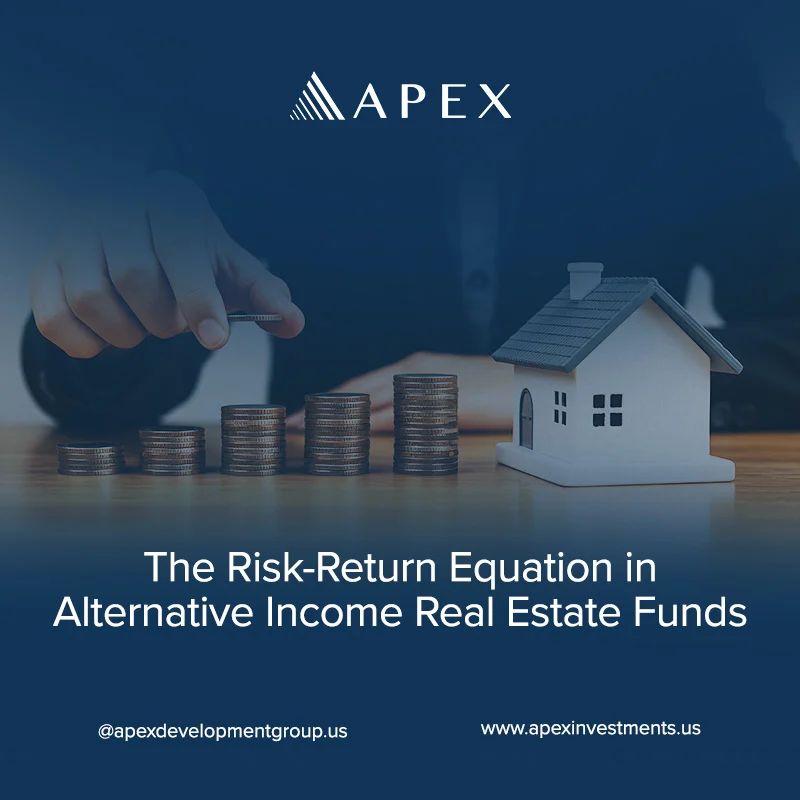
Home The Risk-Return Equation in Alternative Income Real Estate Funds Blog · November 19, 2025 The pursuit of consistent, non-correlated income streams is a defining characteristic of modern portfolio management. In this environment, Alternative Income Real Estate Funds have emerged as a sophisticated solution, offering investors a unique position on the risk-return spectrum. These funds go beyond traditional stock-and-bond investing, focusing on assets that generate steady cash flow, often with lower volatility than publicly traded securities. Understanding the balance between the inherent risks and the desired returns in this niche is essential for successful allocation. Defining the Alternative Income Mandate Alternative income real estate strategies, such as those implemented by Apex, focus on acquiring and managing properties across diverse sectors and investment profiles. The core mandate of funds investing here is to deliver a higher component of current income, rather than relying solely on property appreciation. This contrasts sharply with value-add or opportunistic strategies, which prioritize capital gain and thus sit higher on the risk-return scale. The appeal of these funds lies in their inflation-hedging properties, as rental income often adjusts upward with rising costs. They provide diversification away from core commercial sectors, offering resilience during cyclical downturns. This approach aims for consistent cash yields, making them attractive to income-focused investors. Decoding the Risk Side of the Equation While these funds generally target lower volatility than equity funds, they are not risk-free. The risk-return equation starts with assessing liquidity. Unlike publicly traded REITs, private passive income fund investments can be illiquid, requiring investors to commit capital for multi-year periods. Furthermore, general sector-specific risks are critical; funds must manage the unique operational and occupancy risks inherent in any real estate investment. The nature of the income is the next variable. Funds that specialize in high-quality, long-term leased assets often align closer to a fixed income real estate fund profile, featuring more predictable cash flows but potentially lower total returns. Conversely, funds with shorter-term leases or exposure to operations-intensive property types may offer higher income yield in exchange for greater operational and lease rollover risk. The Return Components: Yield and Appreciation The return generated by these funds is typically a blend of two factors: current cash distribution (yield) and capital appreciation (value change). A fund’s target is usually optimized for the yield component. For investors focused on generating passive income real estate (the foundational element), this predictable cash flow is the primary motivator. The focus shifts from speculative growth to sustainable, recurring distributions. Income Yield: Represents net operating income (rent minus expenses) distributed to investors, usually quarterly. Capital Appreciation: The increase in the underlying property value over the investment horizon, often realized upon sale. Leverage Effect: The use of prudent debt to enhance the yield on the equity portion, a key driver of both risk and return. Strategic Allocation of Alternative Income Investments For a diversified portfolio, including these funds can reduce overall volatility by adding a non-correlated asset class. For high-net-worth investors and institutions, alternative income investments serve as an essential part of the fixed-income allocation, providing higher yield potential than traditional corporate bonds while maintaining some capital stability. The key is in the selection process, favoring funds with seasoned managers who have specialized experience in the target real estate sectors. Manager Expertise and Due Diligence The success of a fund heavily depends on the manager’s ability to underwrite deals, source assets off-market, and manage property operations efficiently. In alternative real estate, operational expertise is paramount—especially in fields like healthcare or specialty logistics. Due diligence must therefore extend beyond the assets to the fund sponsor’s track record, fee structure, and alignment of interests with its limited partners. Look for fund managers who have successfully navigated multiple real estate cycles within the specialized sector. Scrutinize the fee structure, paying close attention to management fees and performance hurdles. Assess the fund’s exit strategy, ensuring it aligns with your investment time horizon and liquidity needs. Navigating the Future of Real Estate Income As investors continue to search for higher yields in a lower-rate environment, the demand for this asset class will only increase. Fund managers are continually innovating to structure products that meet specific investor goals, such as offering diversified portfolios designed to provide targeted, consistent returns. These funds are no longer just an “alternative” choice; they are becoming a core building block for portfolios seeking durable income. The analysis remains constant: the relationship between liquidity, operational risk, and yield must be balanced to meet specific financial objectives. Investors interested in learning how to structure these investments should review our analysis on how to maximize returns through various strategies: passive income real estate. The long-term success of these allocations is predicated on disciplined underwriting and a commitment to specialized asset management, an area of focus for Apex Development Group. Previous PostWhat September’s Inflation Data Means for Investors and Real Estate in America?
Multi-Asset Portfolio Strategies That Outperform Single-Asset Bets

Home Multi-Asset Portfolio Strategies That Outperform Single-Asset Bets Blog · November 10, 2025 When investors think about wealth creation, they often face a big choice: should they put all their money into a single asset class—like stocks or real estate—or build a multi-asset portfolio? While single-asset bets can feel straightforward, they often expose investors to concentrated risks. Multi-asset portfolio strategies, on the other hand, spread investments across different sectors and vehicles, balancing risk with higher long-term performance potential. In today’s volatile financial landscape, diversification is more than a buzzword—it’s a proven strategy for consistent returns. By blending real estate investment opportunities, alternative investments, and equity or fixed-income holdings, investors can capture upside while reducing the impact of market swings. Why Single-Asset Bets Fall Short Concentrating on a single asset type—such as only equities or only bonds—makes investors vulnerable to downturns in that sector. For example, investors heavily exposed to tech stocks in 2022 saw portfolio values plunge, while those solely dependent on bonds struggled with rising interest rates. Similarly, committing only to real estate without flexibility can limit liquidity. Even though real estate investment remains one of the strongest asset classes for wealth preservation, it alone cannot balance inflation shocks, interest rate spikes, or liquidity crises. A multi-asset strategy solves this by weaving together real estate, alternative funds, equities, and fixed-income solutions into one structured portfolio. The Core of a Multi-Asset Portfolio A successful multi-asset portfolio rests on three pillars: Diversification Across Asset Classes – Mix income-generating real estate, equities for growth, and alternatives for stability. Active Risk Management – Adjust allocations based on market cycles, inflation trends, and global economic shifts. Alignment With Investor Goals – Whether the objective is passive income, capital appreciation, or long-term stability, the mix must match personal or institutional priorities. Real Estate as the Anchor Asset Among alternatives, real estate continues to be the cornerstone of resilient portfolios. Unlike stocks or crypto, real estate delivers tangible value: income through rents, appreciation over time, and tax advantages. Passive income real estate funds allow investors to participate without the hassles of property management. Multifamily real estate investing provides steady rental cash flows, supported by rising demand for housing in metro areas. Specialized structures like build-to-rent communities and syndications allow investors to diversify across geographies and property types while remaining hands-free. These strategies not only enhance portfolio income but also cushion against inflation. The Role of Alternative Investments While traditional assets dominate most portfolios, forward-looking investors are turning to alternative investments to strengthen resilience. These include: Private real estate investment funds Hedge funds and private equity Infrastructure and energy projects Alternatives provide uncorrelated returns—meaning they often move differently than stocks and bonds. This helps stabilize overall portfolio performance, especially during periods of market turbulence. Building Consistent Income Streams Multi-asset strategies thrive when income is diversified. Combining traditional dividends and bond coupons with alternative income investments like real estate syndications or passive income funds gives investors multiple cash flow streams. For example: A passive income real estate investment fund may provide quarterly distributions. Equity holdings can add dividend growth. Alternative income funds may yield inflation-hedged returns. This combination builds both short-term stability and long-term compounding wealth. Case Study: Real Estate + Alternatives + Equities Consider an investor allocating $1 million across three asset groups: 40% in multifamily real estate investing (steady rental cash flow, tax benefits) 30% in alternative investments (private real estate funds, infrastructure) 30% in equities and fixed income (growth and liquidity balance) This portfolio captures the predictable yield of real estate, the downside protection of alternatives, and the liquidity and appreciation potential of equities. In back-tested models, such a strategy often outperforms single-asset allocations over 10–15 years. Inflation-Proofing Portfolios With inflation eroding purchasing power, the ability to preserve real returns is critical. Real estate naturally hedges inflation through rising rents and asset appreciation. Meanwhile, certain alternative income investments are structured to perform well when inflation spikes. Adding real assets to a multi-asset portfolio ensures income streams rise with cost-of-living pressures, protecting long-term wealth. Passive Income Without Complexity A common myth is that diversification equals complexity. But modern fund structures allow investors to enjoy a diversified portfolio with minimal day-to-day involvement. Hands-free investing platforms now package real estate, alternatives, and fixed-income assets into accessible funds. Investors can choose between conservative or aggressive allocations, depending on their appetite for growth versus stability. This approach brings professional management into play, ensuring assets are actively rebalanced for performance. Why Multi-Asset Portfolios Outperform Multi-asset portfolio strategies have repeatedly demonstrated stronger risk-adjusted returns compared to single-asset bets. The reasons are clear: Reduced Volatility – Diversification spreads risks. Steadier Income – Multiple sources of yield create consistent cash flow. Capital Growth – Exposure to equities and real estate supports appreciation. Resilience in Downturns – Alternatives and inflation-proof assets offset market shocks. For investors seeking sustainable growth with managed risk, multi-asset is not just an option—it’s the smarter path. Final Takeaway The era of single-asset bets is fading. Today’s market demands flexibility, diversification, and foresight. A multi-asset portfolio—anchored by real estate investment opportunities, strengthened with alternative investments, and complemented by equities and fixed income—can consistently outperform, offering both stability and growth. For investors exploring new strategies, now is the time to step beyond concentrated bets and embrace a holistic, diversified portfolio. Previous PostThe Risk-Return Equation in Alternative Income Real Estate Funds
What September’s Inflation Data Means for Investors and Real Estate in America?

Home What September’s Inflation Data Means for Investors and Real Estate in America? Blog · October 31, 2025 The latest inflation data released by the Bureau of Labor Statistics, and covered widely by outlets like CNN, paints a nuanced picture of the U.S. economy. Prices continue to rise, but at a controlled pace that suggests inflation is cooling, not collapsing. For investors, this moment calls for discipline, diversification, and a keen eye on the sectors that thrive when inflation levels out, particularly real estate. Inflation Still Sticky, But Showing Signs of Balance The Consumer Price Index (CPI) rose 0.3% in September, bringing the annual inflation rate to 3.0%, a slight uptick from 2.9% in August. While modest, this increase highlights how inflationary pressures remain persistent, even as the Federal Reserve works to stabilize prices. Core inflation, which excludes food and energy, also rose 3.0% year-over-year, underscoring the resilience of price growth across services and essentials. Some key details from the September report: Gasoline prices jumped 4.1% month-over-month, a major driver of headline inflation. Shelter costs, which account for a third of the CPI, increased by only 0.1%, the smallest rise since January 2021 — a sign that housing-related inflation may finally be easing. Food prices climbed modestly, while used car and apparel prices remained stable or declined slightly. While these figures show progress compared to 2022’s inflation spikes, they also indicate that returning to the Fed’s 2% target will take time. What It Means for the Broader Investing Landscape? The 3% inflation mark represents a delicate equilibrium — high enough to keep the Fed cautious, but stable enough to support continued economic activity.For investors, this environment signals a few key dynamics: 1. Interest Rates May Stay Elevated LongerWith inflation slightly above target, the Federal Reserve is likely to maintain its current rate stance. That means borrowing costs will remain relatively high for the near term, affecting both corporate expansion and consumer lending.2. Equities Will Favor Quality and Cash Flow In a higher-for-longer rate environment, investors tend to gravitate toward companies with strong balance sheets, consistent earnings, and reliable dividends — particularly in defensive sectors like utilities, healthcare, and consumer staples.3. Fixed Income Is Back in PlayBonds and treasuries are regaining attention as yields remain attractive. For conservative investors, this is one of the first inflation cycles in years where fixed income provides meaningful real returns. Why Real Estate Still Stands Strong? While rising rates have cooled parts of the housing market, real estate remains one of the most effective inflation hedges — especially in markets with strong population growth and limited supply. Several factors are shaping the real estate outlook in this inflation environment: Easing Shelter Inflation The 0.1% rise in shelter costs suggests that rental growth and housing price acceleration are slowing. However, underlying demand remains strong, especially in the Sun Belt and Southeast regions, where affordability and job growth continue to attract buyers and renters. Institutional Interest Remains High Even as rates rise, institutional investors are holding — and in some cases expanding — positions in multifamily, build-to-rent, and industrial assets, viewing them as long-term inflation-resilient plays. Build-to-Rent (BTR) and Affordable Housing Elevated mortgage rates are keeping many would-be buyers in the rental market, creating sustained demand for professionally managed single-family rentals and affordable multifamily units. Commercial Real Estate Divergence Office assets continue to face pressure, but industrial, logistics, and residential sectors remain attractive given their linkage to demographic and consumer shifts rather than purely speculative cycles. The Bottom Line September’s CPI data confirms that inflation in the U.S. has steadied but not disappeared. For investors, this is not a red flag — it’s a recalibration moment. A 3% inflation world rewards strategic allocation: Real assets like real estate and infrastructure continue to provide inflation protection. Fixed-income investors enjoy stronger yields than in the pre-2022 era. Equity markets favor cash flow stability over speculative growth. In other words, America’s investment landscape is moving from volatility to selectivity — and those who understand how inflation interacts with interest rates, credit, and asset pricing will be best positioned for the next cycle of growth. Previous PostUnlocking Opportunity with Regulation D Rule 506(c): What Every Apex Investor Should Know
Unlocking Opportunity with Regulation D Rule 506(c): What Every Apex Investor Should Know
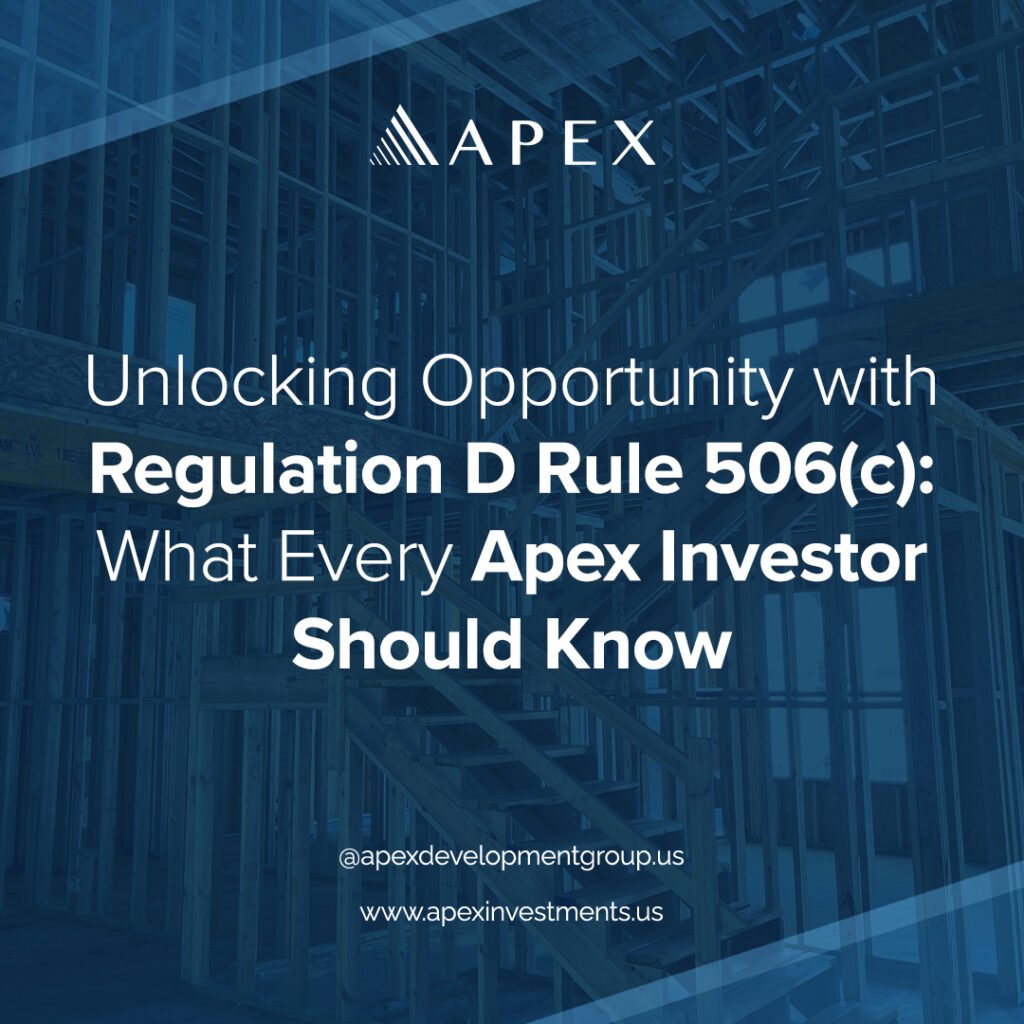
Home Unlocking Opportunity with Regulation D Rule 506(c): What Every Apex Investor Should Know Blog · October 7, 2025 At Apex Development Group, our mission is to deliver exclusive, high-performing real estate investment opportunities to qualified investors. One of the most important tools that allows us to do this is Regulation D, Rule 506(c) — a powerful exemption that opens the door to raising capital while maintaining compliance with federal securities laws. In this article, we’ll explain what Rule 506(c) is, how it differs from other exemptions, and why it plays a vital role in how we structure our investment offerings for long-term success. What Is Regulation D, Rule 506(c)? Regulation D is a set of SEC rules that allow companies to raise capital through private securities offerings without registering with the SEC. Within this framework, Rule 506(c) is a specific exemption that allows issuers like Apex to: Publicly market and advertise investment offerings Raise an unlimited amount of capital Accept investments only from accredited investors This rule gives us the flexibility to reach a broader audience while ensuring that participants meet strict financial qualifications, helping protect both the investor and the integrity of the offering. Who Qualifies as an Accredited Investor? To invest under Rule 506(c), you must be an accredited investor. This means meeting at least one of the following criteria: Income-based qualification: Earned over $200,000 individually (or $300,000 jointly with a spouse or partner) in each of the past two years, with the expectation of earning at least that much in the current year. Net worth-based qualification: Have a net worth exceeding $1 million, either alone or with a spouse, excluding the value of your primary residence. Professional certification:Hold a Series 7, Series 65, or Series 82 financial license. Entity qualification: Certain trusts or LLCs may also qualify if they have more than $5 million in assets or if all beneficial owners are accredited. Not sure whether you qualify? Our team can help guide you through the verification process. How Rule 506(c) Differs from Other Investment Options Rule 506(c) stands out from other exemptions (like Rule 506(b)) in a few key ways: Public Advertising Is Allowed We are permitted to market our offerings through websites, social media, webinars, and more — giving us greater visibility and reach. Only Accredited Investors Can Participate Unlike Rule 506(b), we cannot accept non-accredited investors under 506(c). Accreditation Must Be Verified Investors must go through a formal verification process. Self-certification (just checking a box) is not enough under this rule. These distinctions are what make Rule 506(c) ideal for firms like Apex and for experienced investors who are ready for long-term opportunities. What the Accreditation Process Involves To comply with SEC rules under 506(c), Apex must take reasonable steps to verify each investor’s accredited status. This means you’ll need to provide documentation such as: Recent tax returns or W-2s Statements of assets and liabilities A written confirmation letter from a CPA, attorney, or financial advisor We’ve partnered with professional third-party verification providers to ensure that the process is quick, secure, and confidential. Why Apex Uses Rule 506(c) At Apex Development Group, we’ve chosen to use Rule 506(c) for several strategic reasons: Wider Reach We can share our offerings publicly, which helps us connect with qualified investors more efficiently. Investor Protection The accredited investor requirement ensures that participants are financially prepared and understand the nature of long-term private investments. Regulatory Confidence We believe in full transparency and compliance with SEC standards. Efficient Fundraising Because we target qualified investors, we’re able to raise capital faster and more securely. What to Expect When You Invest with Apex When you invest through a Rule 506(c) offering, here’s what you can expect: Minimum Investment Typically between $25,000 and $100,000, depending on the project. Investment Horizon Our typical holding period is between 5 to 7 years, designed to optimize long-term returns. Passive Income Potential You earn income while we manage the property and operations — ideal for investors seeking hands-off opportunities. Full Transparency We provide detailed offering documents, performance updates, and open communication at every stage. Understand the Risks As with any investment, there are inherent risks to consider: Illiquidity These are long-term investments — your capital may be tied up for several years. Market Conditions Real estate values can fluctuate due to economic and local factors. No Guaranteed Returns As with any investment, returns are not guaranteed. We encourage every investor to perform due diligence, consult a financial advisor, and ensure the investment aligns with their goals and risk tolerance. Ready to Learn More? If you’re an accredited investor looking for smart, passive real estate investment opportunities, Apex is here to help. We combine strategic insight with deep market expertise to help you grow your wealth with confidence. Reach out today to explore current offerings, complete your accreditation verification, and take the next step in your investment journey. Let’s build something lasting — together. Disclaimer: This article is for informational purposes only and does not constitute an offer to sell or a solicitation of an offer to buy any securities. All investments involve risk and may result in loss. Offers are made only through official offering documents and in accordance with applicable securities laws. Previous PostThe Inflation-Proof Play: Using Fixed Income Real Estate Investments to Preserve Wealth
The Inflation-Proof Play: Using Fixed Income Real Estate Investments to Preserve Wealth
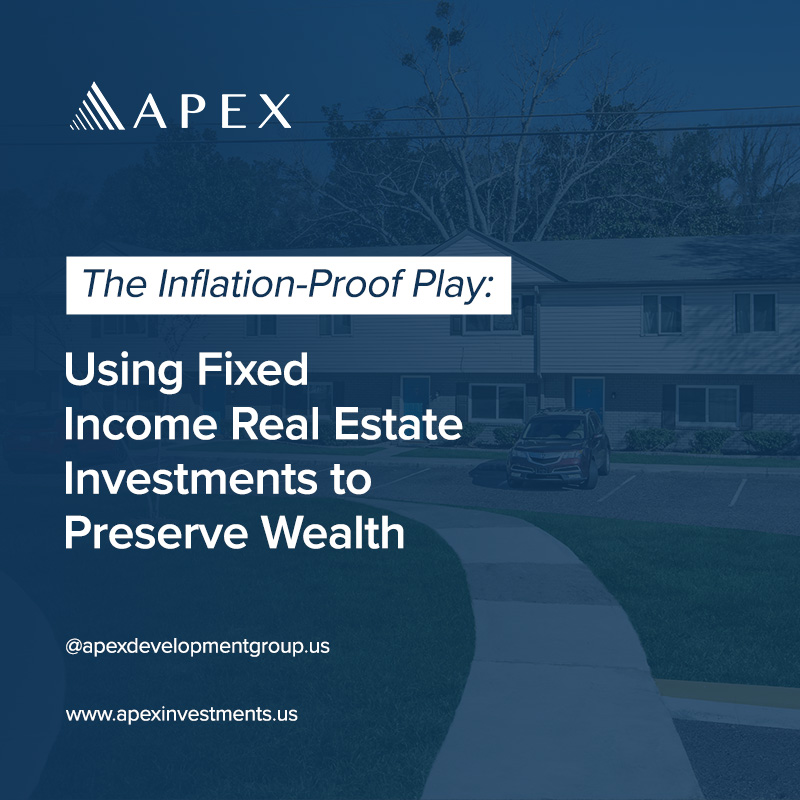
Home The Inflation-Proof Play: Using Fixed Income Real Estate Investments to Preserve Wealth Blog · October 1, 2025 Introduction: Protecting Wealth in an Inflationary World Inflation is one of the most persistent threats to long-term wealth preservation. When the cost of living rises, traditional assets such as savings accounts, bonds, or even certain stocks often fail to keep pace with inflation. For investors seeking stability, security, and reliable returns, fixed income real estate investments are emerging as one of the most effective strategies to protect purchasing power. Unlike speculative market plays, real estate investments rooted in income-generating assets provide a cushion against economic volatility. With rising demand for rental housing, multifamily developments, and build-to-rent models, investors now have more avenues than ever to access inflation-proof investments that also deliver steady passive income. In this article, we’ll explore why fixed income real estate is the ideal hedge against inflation, how multifamily real estate investing fits into this trend, and why alternative investments like these are critical for building wealth that lasts. Why Fixed Income Real Estate Investment Matters The term fixed income real estate investment refers to structured opportunities where investors earn predictable cash flow from real estate assets. Unlike equities that swing with market speculation, these investments are tied to long-term leases, rental income, or structured debt financing. Key advantages include: Stable Returns: Investors receive consistent payouts backed by rental or interest income. Capital Preservation: Real estate is a tangible asset, offering collateral-backed security. Inflation Hedge: Rental rates generally rise with inflation, protecting returns. For high-net-worth individuals, family offices, or institutional investors, these fixed income vehicles are particularly attractive. They combine the safety of fixed returns with the growth potential of real estate appreciation.Passive Income Real Estate Investments: Building Wealth Hands-Free One of the most compelling aspects of real estate today is the ability to generate passive income real estate investments without becoming a landlord. Thanks to professionally managed funds and syndications, investors can participate in large-scale projects without the headaches of property management. These investments provide: Monthly or quarterly distributions directly tied to rental cash flows. Hands-free investing where seasoned managers handle acquisition, operations, and tenant management. Tax advantages such as depreciation benefits and potential 1031 exchanges. Whether it’s a multifamily real estate fund or a build-to-rent community, passive income strategies allow investors to scale wealth while freeing up time. For busy professionals and retirees alike, it’s one of the most efficient ways to achieve long-term financial freedom. Multifamily Real Estate Investing: The Core of Inflation-Proof Portfolios Of all property types, multifamily real estate investing has proven to be one of the most resilient. Housing is a necessity, and demand for quality rentals continues to grow, especially in markets like Atlanta, Georgia, and other high-growth regions. Why multifamily is so powerful: Consistent Occupancy: Even during downturns, people need housing. Scalable Cash Flow: Dozens or hundreds of units generate diversified rental streams. Value-Add Potential: Renovations and improved management can significantly boost returns. Liquidity Options: Multifamily syndications and funds make it easier to buy in and cash out. Institutional investors have long relied on multifamily assets as a stabilizing force in their portfolios. Today, individual investors can also participate through structured funds or syndications, accessing opportunities that were once out of reach. Alternative Investments: Beyond the Stock Market Relying solely on traditional markets is no longer enough. With stock volatility and bond yields struggling to outpace inflation, sophisticated investors are increasingly turning to alternative investments.Real estate funds, private equity, infrastructure, and multi-asset portfolios fall into this category. These vehicles are designed to: Diversify risk away from Wall Street Provide uncorrelated returns that don’t move with the stock market Deliver steady income streams regardless of short-term market noise Among all alternatives, real estate investment funds—particularly those focused on fixed income—offer the most balanced combination of security and yield. They provide exposure to essential housing demand while insulating investors from stock market swings. Inflation-Proof Investments: Why Timing Matters Now In 2025, inflation continues to impact everyday costs, from groceries to mortgages. For investors, this environment is a wake-up call. Holding cash erodes wealth, while bonds may lag behind rising prices. That’s why positioning into inflation proof investments is not optional—it’s essential. Real estate-backed income streams stand out because: Rents increase with inflation, boosting cash flow. Tangible assets retain intrinsic value even in volatile economies. Long-term demand for housing ensures durability of income streams. For investors looking for the best inflation proof investments, fixed income real estate funds are at the top of the list. They provide both immediate yield and long-term appreciation, making them a cornerstone of smart portfolio design. How Apex Investments Helps Investors Stay Ahead At Apex Investments, our mission is to give investors access to institutional-grade real estate opportunities that provide predictable income and long-term security. Through a focus on fixed income real estate investments, multifamily funds, and carefully selected alternative strategies, we help clients build resilient portfolios designed to weather inflation and market uncertainty. Whether you’re seeking passive income real estate investments for retirement planning or looking to diversify into alternative investments that outperform traditional markets, Apex delivers tailored solutions to meet your wealth-building goals. Conclusion: Securing Your Financial Future In times of uncertainty, the best strategy isn’t speculation—it’s preservation. By leveraging the power of fixed income real estate investment, investors can achieve stability, reliable cash flow, and protection against inflation. Combining passive income real estate investments, multifamily real estate investing, and a broader approach to alternative investments, today’s portfolios can remain resilient even as markets fluctuate. For those seeking truly inflation-proof investments, the time to act is now. At Apex Investments, we help investors unlock these opportunities with confidence. The path to long-term wealth preservation starts with strategies that stand the test of time—and real estate is proving, once again, to be the most dependable asset class of all. Previous PostAlternative Income Investments: Why Smart Investors Are Diversifying Beyond Stocks and BondsNext PostUnlocking Opportunity with Regulation D Rule 506(c): What Every Apex Investor Should Know
Alternative Income Investments: Why Smart Investors Are Diversifying Beyond Stocks and Bonds
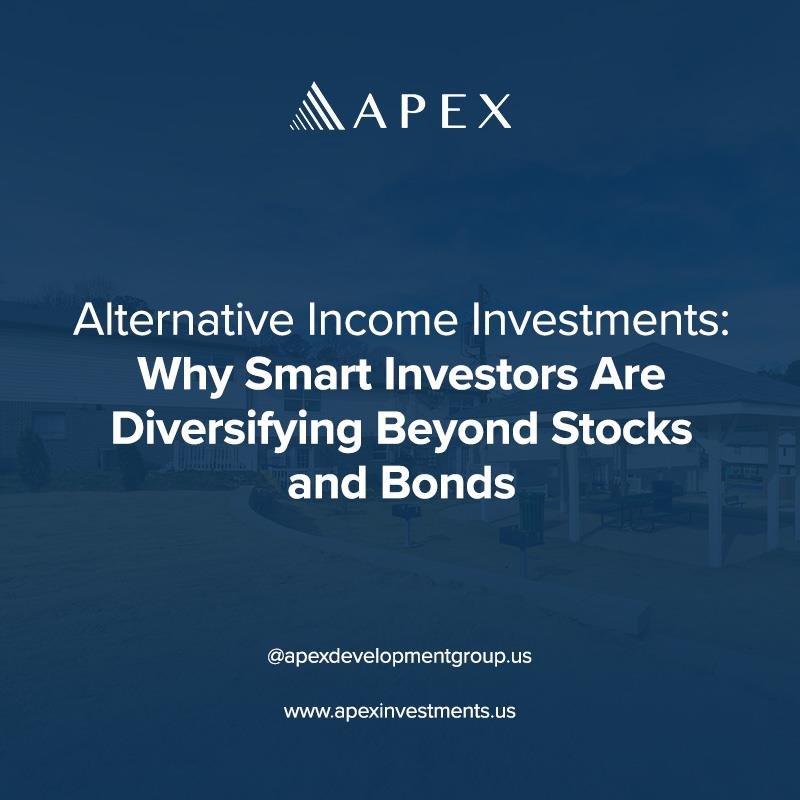
Home Alternative Income Investments: Why Smart Investors Are Diversifying Beyond Stocks and Bonds Blog · October 1, 2025 When the stock market fluctuates wildly and bond yields struggle to keep pace with inflation, investors are forced to ask an important question: Is there a smarter way to generate income while preserving capital? For many, the answer lies in alternative income investments—a growing category that provides diversification, resilience, and steady cash flow beyond the traditional 60/40 portfolio. Today’s forward-thinking investors are exploring asset classes such as real estate investment funds, build-to-rent investments, and multifamily real estate investing to create reliable income streams. These opportunities not only offer strong returns but also align with long-term market trends like housing demand, demographic shifts, and the desire for passive income. Why Alternative Income Investments Matter The classic portfolio of stocks and bonds no longer provides the same level of security it once did. Rising interest rates and unpredictable market cycles have made bonds less attractive, while equities can swing dramatically with global events. Against this backdrop, alternative income investments are gaining attention. Alternative income investments typically include vehicles such as real estate investment funds, private credit, infrastructure, and other non-traditional assets. What makes them especially appealing is their ability to generate consistent cash flow while reducing correlation to volatile stock markets. For income-seeking investors—whether retirees looking for stability or professionals building wealth—alternative strategies can provide balance, risk mitigation, and long-term growth. Real Estate Investment Funds: A Proven Path to Passive Income Among the most popular alternative investments are real estate investment funds. These funds pool investor capital to acquire and manage income-generating properties, allowing individuals to benefit from real estate without the headaches of being a landlord. The advantages are significant: Diversification across properties and markets: Instead of putting all your capital into one rental property, a fund spreads risk across multiple assets. Professional management: Seasoned operators handle acquisitions, tenant management, and asset optimization. Steady income streams: Well-structured funds generate predictable cash flow through rents and potential appreciation. Investors also gain access to property types—such as multifamily housing, commercial buildings, and build-to-rent communities—that might otherwise be out of reach for individual buyers. Passive Income Real Estate: Investing Without the Landlord Stress One of the biggest attractions of alternative investing is the chance to earn passive income through real estate. Unlike traditional property ownership, where landlords handle repairs, tenant turnover, and late-night calls, passive investors can enjoy the benefits of real estate without the burdens. Options for passive income real estate include: Syndications and funds where investors own shares in large-scale projects. Crowdfunding platforms that make it easier to invest with lower minimums. Private real estate investment companies that focus on specific markets or strategies. For busy professionals or retirees, this model allows capital to work harder in the background while freeing up time for other pursuits. Build-to-Rent Investments: Meeting a Growing Housing Demand A fast-rising trend within alternative real estate is build-to-rent investments. This model involves developing communities of single-family homes specifically for rental purposes, catering to the increasing number of Americans who prefer renting over owning.Why is this strategy attractive? Demographics: Millennials and Gen Z often value flexibility, making long-term rentals appealing. Affordability pressures: Rising home prices and mortgage rates push many families toward renting. Institutional interest: Large funds and investors are allocating billions into build-to-rent communities, recognizing the stability of rental demand. For investors, build-to-rent opportunities provide recurring income and exposure to a segment of the housing market with strong growth potential. Multifamily Real Estate Investing: A Core Alternative Asset While single-family rentals have their appeal, multifamily real estate investing continues to be a cornerstone of alternative income strategies. Apartment complexes and mid-sized rental communities offer reliable cash flow, scalability, and resilience across economic cycles. Here’s why multifamily real estate remains attractive: Economies of scale: Managing 100 units under one roof is often more efficient than scattered single-family rentals. Consistent demand: Housing is a basic need, and demand for rental units tends to stay strong—even in downturns. Value-add opportunities: Renovations, repositioning, and operational improvements can significantly boost returns. For investors seeking income, tax advantages, and potential appreciation, multifamily assets provide a balanced and proven alternative. The Tax Advantages of Real Estate-Based Alternatives Beyond income and diversification, real estate-based alternatives offer significant tax benefits. Strategies like depreciation, 1031 exchanges, and bonus depreciation can help investors shield income from taxes while compounding long-term wealth. For example, when investing through a real estate investment fund, depreciation expenses are often distributed across investors, reducing taxable income. This makes alternatives not only an attractive income source but also an efficient wealth-preservation strategy. Alternative Income Investments as a Hedge Against Inflation Another reason investors turn to alternatives is protection against inflation. Real estate, in particular, tends to perform well when inflation rises because property values and rental income often increase alongside consumer prices. Assets like multifamily housing and build-to-rent communities naturally adjust with the market, making them a strong hedge when traditional bonds lose value. Balancing a Modern Portfolio A modern portfolio strategy is no longer limited to equities and bonds. Instead, savvy investors are allocating a portion of capital toward alternatives, creating a more resilient mix. Consider this approach: Core holdings: Stocks and bonds for growth and liquidity. Alternative income investments: Real estate funds, build-to-rent opportunities, multifamily assets. Specialized strategies: Infrastructure, private credit, or niche funds. The goal is to generate steady income, reduce volatility, and capture opportunities unavailable in traditional markets. Final Thoughts The world of investing is changing, and those who adapt early stand to benefit the most. By diversifying into alternative income investments—including real estate investment funds, passive income real estate, build-to-rent investments, and multifamily real estate investing—investors can unlock new streams of income while reducing reliance on volatile markets. As housing demand continues to rise and institutional capital flows into alternative strategies, now is the time to explore opportunities beyond the stock market. For smart investors, the path forward is clear: build a portfolio that generates income, protects against inflation, and thrives
How Passive Income Real Estate Investments Perform When Interest Rates Climb
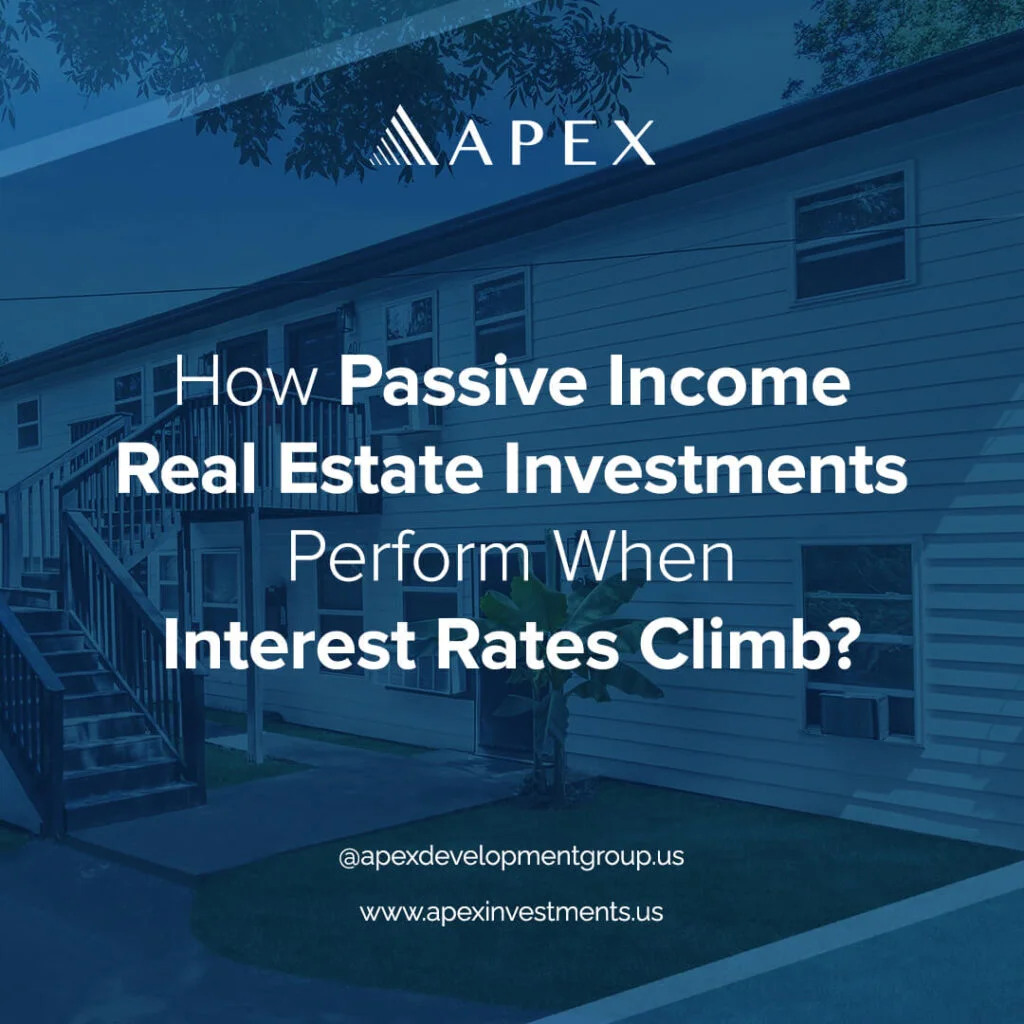
Home How Passive Income Real Estate Investments Perform When Interest Rates Climb Blog · September 9, 2025 In today’s unpredictable financial environment, investors are seeking strategies to build long-term wealth and protect themselves from market volatility. With interest rates fluctuating at levels not seen in decades, many are questioning how different asset classes hold up under such pressure. One area of particular interest is passive income real estate investments—an increasingly popular choice for investors looking for stability, diversification, and predictable cash flow. Unlike stocks or bonds that can see sharp swings with every interest rate hike, real estate—especially passive structures like multifamily real estate funds and build-to-rent investments—often provides a more resilient path toward financial growth. Let’s explore how these investments perform when borrowing costs rise, and why they remain a compelling option for those pursuing passive income streams. The Impact of Rising Interest Rates on Traditional Investments Interest rate increases are primarily designed to combat inflation, but they have wide-ranging implications for investors. Higher rates typically mean: Stocks and equities: Volatility often increases because higher borrowing costs affect corporate profitability and investor sentiment. Bonds and fixed-income securities: Prices fall as yields rise, eroding portfolio values for existing bondholders. Savings accounts and CDs: Rates improve, but returns are still often below inflation. For investors relying heavily on equities and bonds, the environment of rising rates can lead to significant short-term and long-term uncertainty. This is where real estate investment opportunities step in to provide balance. Why Passive Income Real Estate Stands Out Passive income real estate is not about flipping homes or becoming a landlord. Instead, it involves leveraging structures like real estate funds, syndications, and build-to-rent models that allow investors to earn returns without the stress of active property management. The benefits are particularly attractive during periods of rising interest rates: Cash Flow Over AppreciationWhile interest rates can affect property values, passive real estate investments typically prioritize cash flow from rental income. Multifamily assets and build-to-rent communities generate consistent income streams that are less sensitive to short-term market fluctuations. Inflation-Resistant ReturnsReal estate, especially rental housing, tends to track with inflation. As the cost of living rises, so do rents. This makes passive income real estate investments a hedge against inflation in ways that fixed-income securities cannot match. Diversification Beyond the Stock MarketWith stocks underperforming in high-rate environments, investors need stock market alternative investments. Passive real estate offers an opportunity to diversify into hard assets that maintain intrinsic value, even in challenging macroeconomic conditions. Multifamily Real Estate: A Proven Hedge Against Rising Rates Among all passive income real estate options, multifamily real estate investing remains a strong performer during times of economic uncertainty. Demand for rental housing continues to rise as mortgage rates climb, keeping homeownership out of reach for many families. This dynamic supports occupancy levels and rental growth in multifamily properties. Key advantages of multifamily real estate funds in rising-rate environments: High Occupancy Resilience: Rental demand often strengthens when interest rates increase, as more people rent instead of buying. Scalable Passive Income: Investors can tap into large, professionally managed assets rather than owning single-family rentals. Tax Benefits: Multifamily funds often provide depreciation and expense deductions that offset income, enhancing after-tax returns. This combination of stability, scalability, and tax efficiency makes multifamily one of the most attractive segments for hands-free investors. Build-to-Rent Investments: A Growing Trend Another segment gaining traction in the passive real estate market is build-to-rent investments. Instead of purchasing existing properties, investors fund the construction of purpose-built rental communities. These assets are designed from the ground up to generate rental income and long-term appreciation. When interest rates rise, build-to-rent investments still perform strongly because: Homebuyers are priced out, increasing demand for rental housing. Purpose-built rental communities attract long-term tenants seeking stability. Professionally managed operations deliver consistent income, even in fluctuating markets. In many markets, build-to-rent is becoming the bridge between traditional homeownership and multifamily living—offering investors a reliable passive income real estate strategy that adapts to demographic and economic trends. Alternative Investments and Passive Income Funds Beyond multifamily and build-to-rent, investors increasingly turn to alternative income investments through structured funds. These funds pool investor capital to acquire, manage, and optimize income-producing properties. By investing in a passive income fund, individuals gain exposure to multiple assets without needing expertise in property management. Advantages of passive income real estate funds: Hands-Free Investing: Professional management takes care of acquisitions, operations, and tenant relations. Risk Mitigation: Diversification across properties and markets reduces exposure to localized downturns. Consistent Cash Flow: Quarterly or monthly distributions provide investors with stable passive income. Compared to volatile stock and bond markets, these funds offer alternative income streams that can thrive even when interest rates climb. Case in Point: Real Estate as a Stock Market Alternative For decades, savvy investors have allocated capital into real estate to balance portfolios and secure long-term growth. When interest rates increase: Stocks decline in value as corporate borrowing costs rise. Bond yields rise, but existing holdings lose market value. Real estate rents increase, strengthening passive income streams. This clear contrast makes real estate investment funds an effective stock market alternative investment, particularly for those seeking predictable income over speculative growth. Tax Benefits: An Overlooked Advantage Another reason passive real estate investing thrives during rate hikes is the tax structure. While rising interest rates affect loan costs, investors in multifamily and build-to-rent funds enjoy benefits such as: Depreciation deductions to offset taxable income. 1031 exchange opportunities to defer capital gains. Pass-through taxation in many fund structures, enhancing after-tax returns. These tax advantages amplify the net performance of real estate investments compared to other interest rate–sensitive assets. The Long-Term Outlook for Passive Real Estate Investments Interest rate fluctuations will always play a role in shaping investor sentiment, but real estate has repeatedly demonstrated resilience across market cycles. Whether through multifamily syndications, build-to-rent communities, or passive income funds, investors can position themselves to weather short-term volatility while building sustainable wealth. The future of passive
The Overlooked Advantages of Real Estate Investment Funds in Volatile Markets
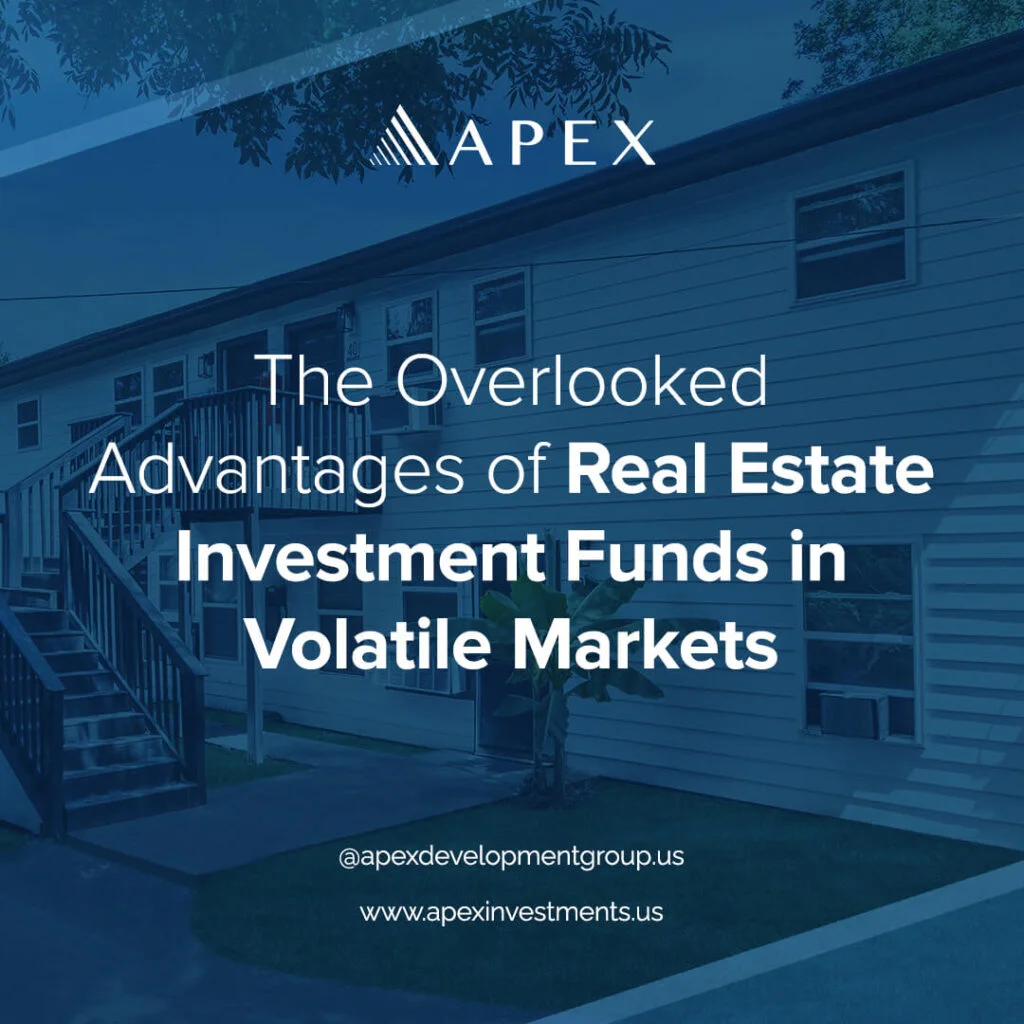
Home The Overlooked Advantages of Real Estate Investment Funds in Volatile Markets Blog · September 1, 2025 When the stock market becomes unpredictable, many feel stuck—should they panic and sell, or stay invested through the turbulence? Here’s a smarter, calmer option: real estate investment funds. These are excellent stock market alternatives—but most people don’t know their full potential. In this article, we’ll explore why real estate investment funds are becoming increasingly attractive, particularly in volatile markets, and how they serve as a strong form of alternative investment for those seeking passive income real estate investments without the hassle of managing properties directly. Why Volatile Markets Demand Alternatives? Volatility in the stock market isn’t new, but the frequency of global shocks—pandemics, inflation swings, political instability, and interest rate shifts—has increased in recent years. For investors who have most of their wealth tied to equities, even short-term downturns can erode gains that took years to build. This is where diversification matters most. Alternative investments like real estate funds provide exposure to an entirely different asset class, one that historically moves independently of stock market cycles. Instead of reacting sharply to daily headlines, real estate tends to follow long-term demographic trends such as population growth, housing shortages, and rental demand. What Is a Real Estate Investment Fund? A real estate investment fund pools capital from multiple investors and directs it toward income-producing properties—such as multifamily apartment complexes, build-to-rent communities, or commercial spaces. Here’s why these funds appeal to investors: Accessibility: Instead of needing millions to buy an apartment building, investors can participate with much smaller contributions. Professional Management: The fund is operated by experienced real estate managers who handle property acquisition, tenant management, maintenance, and exit strategies. Diversification: A single fund may own multiple properties across regions, reducing risk compared to owning one property outright. Passive Returns: Investors receive distributions (typically from rental income) without lifting a finger to manage tenants or repairs. In short, a real estate investment fund allows investors to participate in the real estate market without the direct burden of property ownership. Overlooked Advantages of Real Estate Investment Funds While most investors know that real estate provides steady income and long-term appreciation, the fund model offers additional advantages that are often ignored: Hedge Against Inflation Inflation erodes the value of money, but it often drives rental income higher. Because funds typically focus on rental-producing properties, distributions to investors can rise in tandem with inflation. This creates a natural hedge, unlike fixed-income investments where returns stay flat. Liquidity Options Direct property ownership ties up capital for years, sometimes decades. Many real estate investment funds are structured with defined timelines, allowing investors to exit when the fund liquidates assets. Some funds also provide secondary markets or redemption windows, offering more flexibility than owning a single property outright. Hands-Free Passive Income Investors often underestimate the headaches of managing rental properties—tenant turnover, maintenance calls, compliance, and vacancies. With a passive income real estate investment fund, the management team takes care of everything. Investors simply receive their share of profits, making it ideal for those who want hands-free investing. Resilience During Market Turbulence Unlike stocks, which can lose double-digit percentages in a week, real estate values move more gradually. Even when property values dip, rental demand usually remains strong—especially for multifamily housing, which is a core focus for many funds. This makes them a stabilizing force in volatile times. Professional Oversight & Risk Management Because funds are managed by seasoned professionals, they often conduct deep due diligence on each acquisition. This includes analyzing market demand, neighborhood growth, financing terms, and long-term tenant stability. Individual investors rarely have the expertise or resources to perform this level of analysis. Why Real Estate Funds Work as a Stock Market Alternative? For decades, the stock market has been the “default” investment option. But increasingly, investors are realizing that equities aren’t the only path to wealth. Real estate investment funds represent one of the most effective stock market alternatives for these reasons: Lower Correlation: Real estate doesn’t rise and fall daily with stock indexes. This reduces overall portfolio volatility. Tangible Assets: While stocks are paper claims on companies, real estate is a physical, income-producing asset. Demand-Driven Returns: Population growth, urbanization, and housing shortages continue to drive rental demand, independent of stock market performance. Steady Cash Flow: Quarterly or annual distributions provide a reliable income stream, even if broader markets decline. By allocating a portion of wealth into real estate funds, investors can smooth out returns and reduce the emotional stress of market swings. Passive Income Potential One of the most attractive aspects of real estate funds is the ability to generate passive income without active involvement. Many investors participate specifically for this reason—monthly or quarterly distributions help cover expenses, reinvest in new opportunities, or provide long-term retirement income. Unlike dividend stocks, which can be cut during recessions, rental income is often more stable because people always need housing. This makes passive income real estate investments more predictable than many stock-based income strategies. Who Should Consider Real Estate Investment Funds? While these funds can benefit nearly any investor, they are particularly well-suited for: Busy professionals who want to diversify but lack time to manage properties. Retirees seeking predictable income without the hassles of being landlords. Investors with stock-heavy portfolios looking for balance during volatility. Younger investors who want exposure to real estate but don’t yet have the capital for direct property purchases. Final Thoughts In times of uncertainty, it’s natural to feel cautious about where to put your money. While the stock market will always play a role in wealth-building, investors who ignore real estate investment funds are missing one of the most effective tools for stability, growth, and passive income. As an alternative investment, these funds combine the best aspects of real estate—tangible assets, steady rental demand, and long-term appreciation—with the convenience of professional management and diversification. For anyone seeking a stock market alternative or wanting reliable passive income real estate
Navigating the Complexities of Residential Asset Management

Home Navigating the Complexities of Residential Asset Management Blog · November 25, 2024 Asset management plays an essential role in ensuring the successful operation of Apex’s properties, particularly in today’s challenging environment. Residential Asset Management requires a delicate balance of strategic planning, operational efficiency, and financial judgment. As asset managers oversee large-scale residential properties, they encounter numerous challenges that can significantly impact the bottom line. This article explores into the key challenges and insights that asset managers face, focusing on delinquency metrics, vacancy rates, property refinement, third-party property manager relationships, achieving refinance goals, and the strategic timing of transitions. Delinquency Metrics and Vacancy Management: A Persistent Challenge in Residential Asset Management One of the most pressing challenges in multifamily asset management is managing tenant delinquency, as it erodes revenue streams and increases operational costs. Early identification of potential delinquencies, proactive communication with tenants, and timely eviction procedures are essential. Implementing robust screening processes for new tenants and maintaining strong tenant relationships can help mitigate delinquency risks On the other hand, vacancies can significantly impact a property’s financial performance. Effective vacancy management involves a combination of strategic marketing, efficient leasing processes, and competitive pricing. Understanding local market dynamics and tenant preferences is crucial in attracting and retaining high-quality tenants. However, even with the best strategies in place, these challenges can become insurmountable without the active collaboration of a capable property manager. Property managers play a pivotal role in executing the day-to-day operations necessary to address delinquency and vacancy issues effectively. The Role of Property Managers in Asset Performance Property managers act as the operational bridge between asset management strategies and the on-the-ground realities of running a property. Their responsibilities range from tenant relations and rent collection to maintenance coordination and lease-up efforts. As such, their alignment with the owner’s objectives is critical. When delinquency metrics remain high despite a clear action plan, or when vacancy rates fail to improve even with competitive pricing and marketing initiatives, it may indicate a deeper misalignment. Adapting to Property Management Transitions Transitioning to a new property manager is not a decision to be made lightly, as it involves potential disruption to operations. However, when approached strategically, it can lead to significant long-term benefits. As mentioned earlier, when transitioning to a new property manager, nearly every aspect of operations must be reassessed and adjusted to align with the overarching goals of the property. Operational inefficiencies in areas like rent collection, leasing, and maintenance often become apparent during such transitions. Addressing these requires not only refining workflows but also implementing systems to streamline day-to-day processes. Clear communication and collaboration between the asset management team and the new property manager are essential to ensure a smooth handover and avoid disruptions. Furthermore, marketing plays a critical role during this period. Successfully repositioning the property in its market involves emphasizing its strengths, such as competitive pricing or enhanced amenities, while fostering confidence in its long-term value for tenants and investors. By reinforcing the property’s appeal, teams can maintain leasing momentum and minimize vacancy rates during the adjustment period. Despite the complexities involved, an effective property management transition can set the stage for improved operational efficiency and stronger financial performance. Through streamlined processes, consistent oversight, and open communication, the property can remain on track toward achieving its broader strategic objectives, such as refinancing or portfolio growth. Property Refinancing: A Delicate Balancing Act Refinancing a multifamily property is a strategic process that can unlock significant value and optimize capital structure. However, the success of a refinancing hinges on various factors, including occupancy rates (90% or higher), loan terms, and property performance. Ideally, a stabilized property with consistent income and expenses is the most desirable scenario for a smooth refinancing process. However, market conditions and unforeseen challenges can sometimes disrupt this ideal scenario. For instance, this year Apex encountered a challenging property refinancing scenario. The property faced suboptimal performance, including low occupancy rates and high delinquency rates. To address these challenges and meet stringent lender criteria, the Asset Management team implemented a comprehensive strategy focused on increasing occupancy, improving collections, and achieving specific NOI benchmarks to align with the management’s vision for desired proceeds. The team focused on stabilizing occupancy to improve financial performance. This involved fine-tuning pricing strategies to remain competitive in the market while reevaluating tenant screening processes to ensure new residents could reliably pay rent. Simply filling units was not enough; the team needed to avoid the risk of high delinquency rates, where units were occupied but the expected rental income was not collected. Confronting delinquency also required accelerating eviction processes for tenants with large unpaid balances. Although costly in the short term, these actions helped recover units to return them to the market in better financial standing. Controlling expenses became another critical component of the refinancing effort. Apex worked closely with property managers to emphasize cost efficiency, reinforcing the importance of mindful spending in a business where every dollar impacts the bottom line. These measures ensured that operational performance aligned with the strict metrics required by lenders, and finally lead to a successful refinance operation. Best Practices Driving Apex’s Success in Residential Asset Management Additionally, to the previously described challenges, Apex uses additional strategies to overcome Asset Management complexities. It is important to adopt proven best practices that can significantly enhance property performance and investor returns. These practices focus on maintaining operational efficiency, safeguarding asset value, and staying responsive to market dynamics. Discipline and Communication The most important are the commitment to disciplined management and clear communication, which is further supported by regular internal audits. By conducting weekly and even daily reviews of delinquency rates, occupancy levels, and income performance, the team remains proactive, addressing potential issues before they escalate. This real-time monitoring prevents delays in financial reporting and keeps operations aligned with strategic goals. Effective communication is vital to our success. Regular meetings with property management and leasing teams, coupled with close collaboration with our Corporate Finance team, ensure alignment, accurate cash flow projections, and efficient resource
